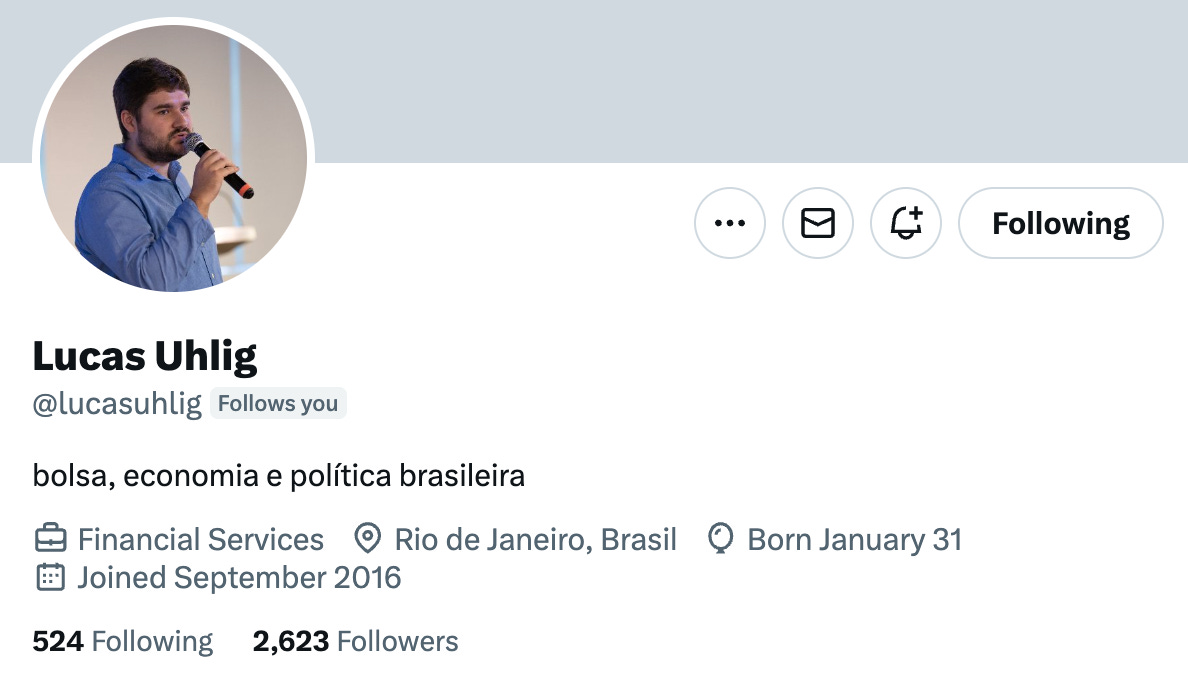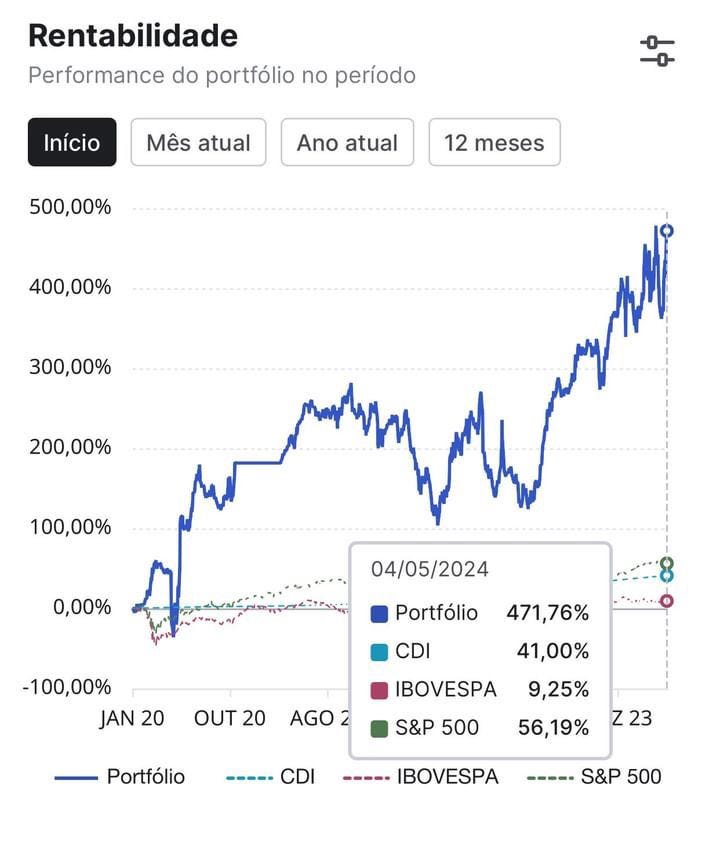Today I have the pleasure of interviewing Brazilian investor Lucas Uhlig.
From January 2020 to July 2024 his historic performance will be the envy of anyone.
His portfolio returned more than 471.76% in the period, versus 9.25% for Ibovespa.
He multiplied the invested capital by 6x!
This guy knows how to generate real value.
Shall we meet him?
BS: Uhlig, could you tell us a little about yourself?
LU: I was born and raised in the countryside of Rio de Janeiro, I am 28 years old, married, father of 2 girls and a great lover of taking risks.
I come from a middle-class family, my mother is a municipal teacher and my father is a sergeant in the Brazilian Air Force. I always had support to study in private schools and this allowed me to earn scholarships in high school and college – which contributed to my academic development and entry into the financial market.
When I turned 18, I moved to the capital of Rio, where I briefly studied Law and later changed my major to Administration. Today I have a postgraduate degree in Administration and am finishing my degree in Finance – I am very passionate about academia and intend to dedicate myself more to it in the future.
About my career, I had the opportunity to work in large companies, such as a large service provider for JSL (now Grupo Simpar), then Itaú Unibanco and I had a brief stint at KPMG, in the auditing department of investment funds. Later, when I was older and getting married, I returned to the countryside, where I had the opportunity to work briefly in local companies before joining TC – a company that taught me a lot and I am very proud of the entire history we built.
Since then, I have spent 10 years working in some way in the financial market, whether in sales, marketing, technology, until I became established in investments.
BS: What is your strategy for making money on the stock market?
LU: I always have half of my liquidity in fixed income and the other half in Brazilian stocks. In fixed income, practically everything is post-fixed, except for some pension plans and a few pre-fixed bonds.
In the stock market, I like to separate them into 3 large blocks:
Companies in a clear process of operational improvement – where management has identified and communicated to the market what needs to be done, but the prices do not match the improvement that will occur. Current examples: Ânima (in the deleveraging part) and Eletrobras (in reducing opex and improving return on equity).
Relevant news and facts involving restructurings or M&As, but which the market does not believe or does not like – these are usually companies with smaller capitalization. A recent example was Kora Saúde and Dasa.
Leverage and options – I love to expose myself to assets that have liquidity in options, but never selling, but buying. Basically, I use dry calls or bullish locks to increase my exposure in scenarios that I consider distorted.
BS: What is your process for finding a new buy opportunity? What filters do you use?
LU: I usually look at the major market themes: Falling/rising interest rates in the near future, inflation and growth expectations, regulatory changes in sectors or consolidation agendas in a given subsector.
It is important to emphasize that in these major themes I always evaluate the position of market experts: in addition to the TC team of contributors, the position of managers whose opinions I highly respect and respect, as well as experts in politics, economics and business. In fact, I am a voracious reader of the main newspapers in circulation in the country – I learned to do so while I worked at Mover (TC's news agency).
Based on this analysis (top), I try to select the companies (down) that would benefit from the themes.
A recent example was strong gains in Oncoclínicas and Dasa betting on the consolidation agenda of the healthcare sector – which I think is still ongoing, along with the discussions of the health insurance bill.
I usually try to find uncorrelated themes to avoid concentration, so I usually have 4 or 5 main themes in the portfolio.
BS: How do you value a share: DCF, Multiples, implied IRR, a mix of the previous ones, …?
LU: I use sell-side reports and the Bloomberg/Reuters consensus to understand what the market believes will happen to companies and, based on these numbers, I create a proprietary model to find the fair value.
In this model, I usually use adjusted multiples of growth, profit and price – always projecting ahead to find a more realistic reference. Then I build a DCF view to try to price more accurately.
Important point: I am not very precious, so it is common to take analysts' models and make adjustments to the assumptions to try to find a price range that I would be comfortable holding the shares.
One of the things I always try to do is to have these price references very clear, especially in times of market stress, so I can have more conviction in holding or increasing the names.
In fact, I am actively working to increasingly reduce the turnover of the more, let's say, fundamentalist positions.
BS: How do you like to build your stock portfolio, considering the number of companies, sectors and concentration?
LU: As I mentioned above, I usually have 4 or 5 main themes, which could be translated into up to 5 different sectors in the portfolio, and from these themes I put together a portfolio with up to 10 stocks, but generally the 3 main positions account for between 60% and 70% of the portfolio. I like to concentrate when I am more convinced.
Examples that have been successful recently were Sabesp and Hidrovias in 2023 and Caixa in 2024.
BS: How often do you like to rebalance your portfolio? How long on average do you hold a position in your portfolio?
LU: I don't usually rebalance my portfolio with discipline – I increase or decrease positions according to the price and market momentum. I usually hold positions between 3 and 6 months.
BS: Do you believe that graphical analysis, together with fundamental analysis, can help with the buying and selling points of stocks?
LU: Absolutely. Although I don't have a profit, I like to look at price regions to deal with support and resistance. In addition to always asking for advice from TC's graphic analysts.
BS: What are your favorite sectors on the Stock Exchange? And the ones you avoid? Why?
LU: I'm quite agnostic in this sense, but speaking of sectors that I like in general, they are sectors with high gross margin, recurring cash generation and a higher level of leverage. Today, one sector that fits these characteristics is the education sector. But we could also include the energy and sanitation sector.
A sector that I don't like is the airline industry – this is a cliché, but it's really hard to understand how they manage to make money. Which doesn't mean that I won't speculate on purchases.
BS: Do you use derivatives? What is your strategy?
LU: I only trade options, I don't like futures contracts. And my options strategy is simple: I buy dry options when there is a trend or when I want to increase my exposure without putting more money in.
I usually buy ATM options when there is a trend and ITM options when I'm "digging deep" lol
BS: What is the cheapest company on the stock market today?





